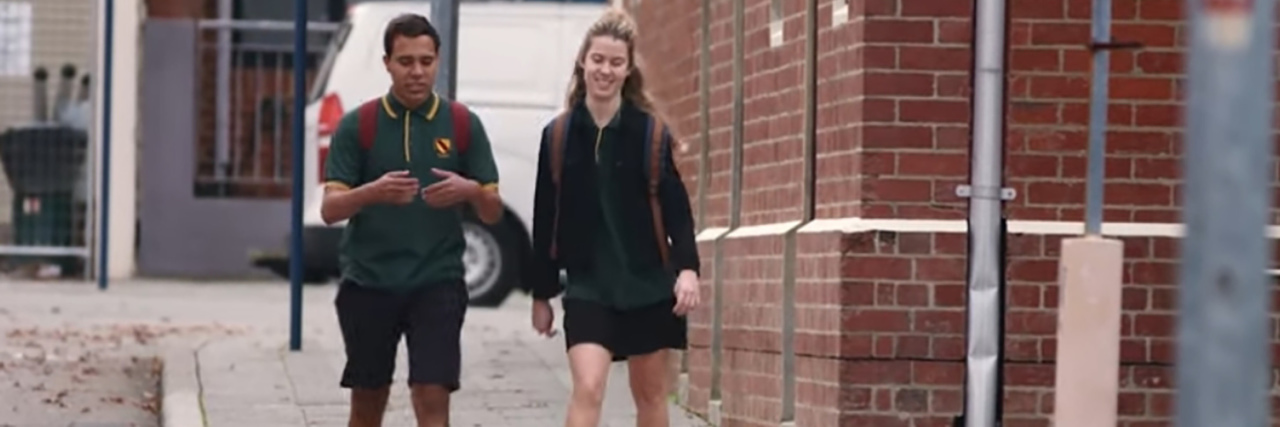Let me pose a theoretical question: When you sit down in the evening in front of Netflix or a television channel, excited to watch one of your favorite programs, do you give any more than a passing thought to why this particular show ranks among your favorites before you grab a snack and get comfortable on the couch?
Recently, asking myself this question resulted in me identifying many things I enjoyed and admired about my favorite television show, “The Heights” on ABC Television in Australia: a talented and diverse cast, dynamic relationships and storylines that deal sensitively and hopefully with many important social issues that can at times be shirked or misunderstood in life off-screen.
However, one reason shone out above all of these: disability representation.
For the first time in my life, I looked at the screen and saw someone I could totally relate to. Sabine (played by actress Bridie McKim), one of the show’s young characters, lives with diplegic cerebral palsy, just like me. She goes to mainstream school, is a talented aspiring actress and navigates the complexities of teenage life with great heart and honesty.
Sabine’s inclusion in the show is not at all tokenistic, nor is the focus exclusively on her disability. I cannot overstate the importance of the inclusion of characters with a disability, portrayed by actors with a disability, in our television and media all the time, not only occasionally. As people who live with disabilities, we have a so often underserved, but essential need to see ourselves reflected in more mainstream media.
Although I have been impressed by Sabine’s storylines throughout the roughly one-and-a-half seasons of the show that have aired so far, it was the episode a week ago that not only caused me to confront my own feelings surrounding internalized ableism, but if a quick read of the show’s social media pages is any indication, it has many viewers thinking about it as well, perhaps for the very first time.
Living with a disability in a world that is so often ill-equipped for even the most basic accommodations that make it possible and comfortable for people with a disability to thrive and make their vital contributions to society, is, most of the time, a delicate balancing act between disclosing our disability or keeping it hidden and between seesawing feelings of pride and shame.
There is always a question of whether someone can be trusted with the “warts and all” version of our experience, of what to share with friends, and of whether we should attempt anything that has traditionally been shown as predominantly the domain of those without disabilities. I often consider just how much to push for inclusion, to do something I am passionate about when it means others will have to make adjustments they aren’t familiar with, and sometimes even change plans so this isn’t necessary.
These are questions Sabine on “The Heights” also grapples with.
I am long past my teenage, high school years, but I am heartened beyond words that those growing up with cerebral palsy today may watch a television show like “The Heights” and feel seen and understood in the characters and plot that plays out on the screen. Growing up isn’t easy, and simultaneously navigating the challenges of disability grows strength, but the price is often pain, frustration and confusion.
“The Heights” does not shy away from these issues, and it strikes the right balance between refusing to sugarcoat the challenging realities of disability while showing how full, diverse and vital life with a disability is, and the right way for people such as teachers and families to respond, even if they are unsure at first.
The portrayal of disability in such a real way has significant potential to take some of the weight of advocacy, often unrelenting, off the shoulders of people with disabilities. It is wonderful to be able to encourage people who may be unfamiliar with disabilities to watch the storylines and characters of shows like this, so they may be able to learn in a non-invasive, even enjoyable way.
Although “The Heights” is only a recent addition to my favorites list, I know it will have its place there for a long time to come. I will recommend it to friends who also live with CP and other similar disabilities, and I will forever be grateful to Bridie, and the team behind “The Heights” for showing Australia that alongside the challenges of living with a disability, there is plenty of normality too. They have set the bar high; there may it remain.

